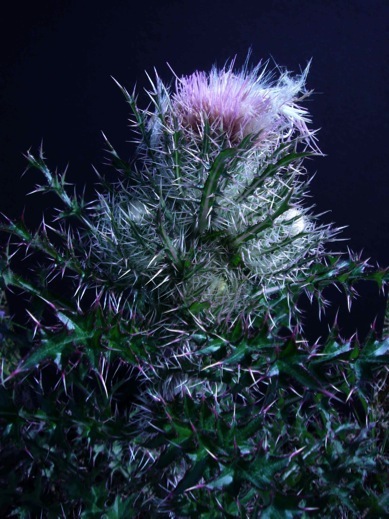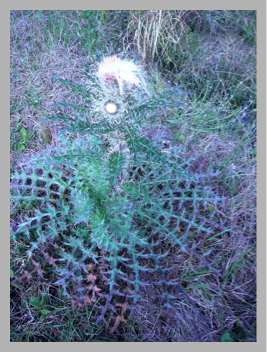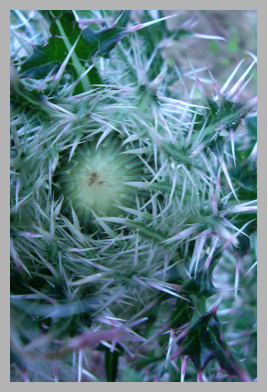Thistle: Touch me not, but add butter
Thistles, you’re either going to love ’em or hate em. Of course, I think eating them is the sensible compromise.
Thistles, in this case Cirsium horridulum (SIR-see-um hor-id-YOO-lum) are among the hardest to gather of wild foods, Black Walnuts probably being the worst. But, the reward is edible stalks, edible leaves —trimmed of spines — roots and unopened flower bud bottoms. Like many tasty wild plants, the thistle did not make its way into main stream food channel because of the spines and its two-year growth habit. The first year the plant is just a root and a rosette, the second year it sends up a stem and blossoms.
The first-year root and leaves are edible, but there isn’t much of a root for a while. The leaves are edible but don’t even bother trying to cut off the spines. That’s too labor intense. Just strip the green off the leaf leaving the very edible midrib. Rub the “wool” off and enjoy, raw or cooked. All thistles in the genus Cirsium, and the genus Carduus, are edible. Or said another way, there is no poisonous true thistle, but not all of them are palatable.
In the second year plant the inner core of the flower stalks is quite tasty and not that much work. The leaves are still edible if you strip them of spines as are the bottom of the flower buds, though the bud bottoms aren’t much more than a nibble. All can be eaten raw, steamed or boiled. (Or roast whole by a fire and squeeze the cooked core out.)
Of course, one should wear heavy gloves when working with thistles, and some people have contact dermatitis with thistles, so make sure first. Personally, I prefer the stalks of second year plants in spring, when they are a foot or so high. I just use a long-handled shovel to cut them at the base above the rosette. With heavy gloves and a trimmer I hold the plant upside down and cut off the leaves and sundry spines. Carefully peel the stalk of the fibrous coat, which is most of the green you’ll see. Then you can eat it raw or cooked, I prefer cooked. I think the stalk boiled a few minutes and then served with butter, salt and pepper is absolutely delicious, for a green.
The plant also grows fibrous as it ages — why we don’t eat older stalks — and can be used for cordage. Soaking the plant several days in water makes the threads available. Also, the seed fluff when dry is great tinder. And should you be in the wilderness with little but a thistle for protection, know the Seminole Indians made blowgun darts from the plant. That might require a remaking of the common phrase: I’ve got a thistle stuck in the thick of my tongue. The down was used as guide feathers for arrows.
Incidentally, it’s shaving brush-shaped flowers can be purple or yellow. Personally, I have never seen a yellow one. If by some outside chance you have misidentified the prickly Mexican poppy (Argemone mexicana) for the thistle, the poppy has yellowish sap and flowers, white or yellow, with petals. The thistle’s flower is like a shaving brush when in bloom that then turns into a cottony ball of fluff.
The thistle, which is in the sunflower family, is often called an invasive weed even where it is native. What is native? It can be found around the world and throughout North American and Canada, even in the arctic circle and Greenland, just like the mustard plant, chickweed and blackberries. Thistles can be found from valley bottoms to mountain tops. All you need to be is observant, and hungry. The thistle shown here, C. horridulum, grows from from Maine south along the seacoast to Florida, west from South Carolina to Texas. When I was a boy growing up in southern Maine this thistle grew every year across the road from our house. Now, it so happens that I went to school eight years in one-room school houses. An annual project, as directed by Mrs. Arlene Tryon, was to bring unopened thistle blossoms to school, hang them up, and watch them turn into cotton puffs. The thistle, by the way, is also food for the larva of the American Painted Lady butterfly, Black Swallowtail, Delaware skipper, Palamedes Swallowtail, Palmetto Skipper), Three-Spotted Skipper, Twin-Spot skipper (What? No One-spotted skipper?) and other butterflies. Goldfinches like the seeds, too.
A tea can also be made from the leaves and the plant was used in ancient times to treat varicose veins, which in Greek is kirsos. After being bastardized by Latin, Kirsos becomes Cirsium. Horridulum means a little spiny, clearly a joke by Andre Michaeux the botanist who named it. (Also, on something almost completely unrelated, it’s a cute linguistic and conceptual hop from kirsos, varicose veins, to kissos, which means ivy.)
Oh, and a parting factoid: Thistle root gives some folks gas. Thought you’d like to know ahead of time.
Green Deane’s “Itemized” Plant Profile
IDENTIFICATION: Biennial or perennial herb, two to five feet high, basal and stem leaves lobed, lower stems leaves can be four to nine inches long, can be woolly in parts, second year stems stopped with shaving-brush flowers, purple or yellow. In some species the branching can be throughout the stalk, in the bull thistle branching occurs only on top. Very spiny, one tough plant. If by chance you have misidentified it with a spiny poppy the poppy has flowers with large petals. If you are in Florida and on the west coast you might see Cirsium nuttallii, which is tall and skinny with many branches.
TIME OF YEAR: Best in spring, first or second year, starting in February in Florida, later in northern climes. In Florida the seasons can be mixed with the plant not taking a break between first and second year growth.
ENVIRONMENT: Sandy open areas, moist or dry, old fields, roadsides, often the only plant still untouched in closely cropped pastures. Some reports say they like wet areas but that certainly is not the case here in Florida.
METHOD OF PREPARATION: Raw, boil or steamed hollow inner stalks peeled of green outer fiber; core of unopened flower buds, when cooked squeezed out like artichoke leaves; stripped midribs raw or cooked. First year roots once large enough to harvest, The seeds are edible, 12 pounds will produce 3 pounds of edible oil. Suitable for cooking or lamp use.
HERB BLURB
Native American Indians used thistle for neuralgia, over eating, an herbal steam for rheumatism and to shrink hemorrhoids (presumably without the thistles!)




